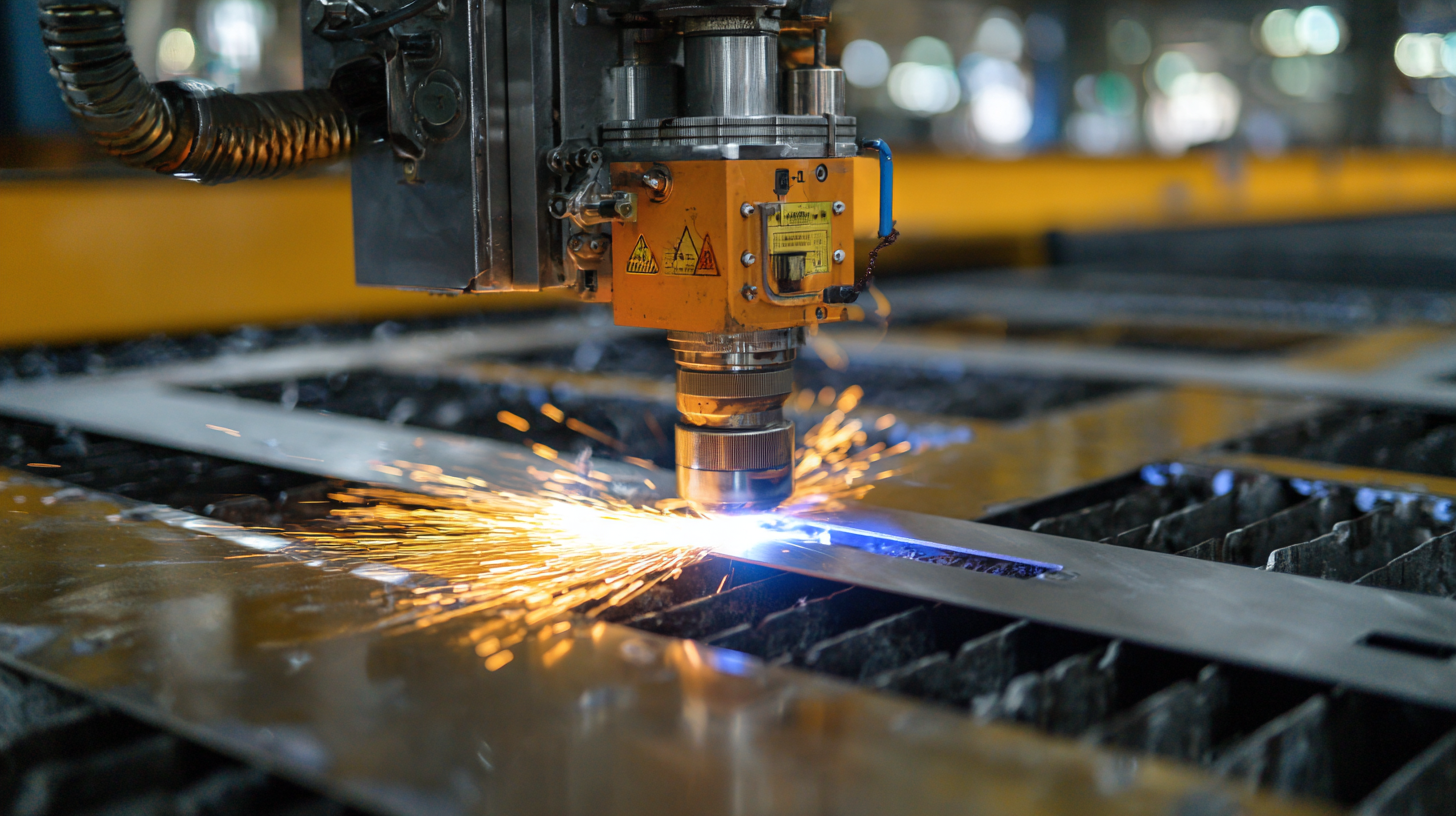Understanding the Specifications of the Best Industrial CNC Plasma Table and How to Use It
In today's manufacturing landscape, the industrial CNC plasma table stands at the forefront of technological advancements, revolutionizing processes across various sectors. According to a report by MarketsandMarkets, the global CNC cutting machines market is expected to reach $5.5 billion by 2024, highlighting the increasing reliance on precision and efficiency in industrial applications.

This surge in demand is largely driven by the need for high-speed cutting capabilities and the ability to handle various materials with unmatched accuracy. With manufacturers around the world, particularly in China, embracing these technologies, the "world-class manufacturing" ethos not only showcases national pride but also positions China as a key player in the global export market.
Understanding the specifications and operational techniques of the best industrial CNC plasma tables is crucial for businesses aiming to enhance productivity and maintain a competitive edge in this dynamic environment.
Key Features to Consider When Selecting an Industrial CNC Plasma Table
When selecting the best industrial CNC plasma table, there are several key features to consider to ensure optimal performance and productivity. The plasma cutting machine market is experiencing robust growth, projected to reach significant valuations by the end of the decade. A report highlights that CNC/automated cutters are gaining prominence, accounting for over 60% of the market share, thanks to their superior precision and efficiency compared to manual alternatives. Companies are increasingly investing in these advanced machines to boost their manufacturing capabilities.
Tips for choosing the right CNC plasma table include assessing the cutting thickness and material types you’ll be working with, as different machines come with varying specifications. Make sure to also evaluate the software compatibility and ease of use; a user-friendly interface can significantly reduce training time and increase operational efficiency. Additionally, consider the machine's overall build quality and after-sales support offered by the manufacturer, which are crucial for long-term reliability and service.
 China's rapid progress in advanced industries fuels innovation in CNC plasma technology. With robust investments in R&D from both universities and domestic companies, the country's manufacturing capabilities are being transformed, leading to more sophisticated and affordable plasma cutting solutions entering the global market. This evolution creates added pressure on businesses worldwide to upgrade their equipment to remain competitive.
China's rapid progress in advanced industries fuels innovation in CNC plasma technology. With robust investments in R&D from both universities and domestic companies, the country's manufacturing capabilities are being transformed, leading to more sophisticated and affordable plasma cutting solutions entering the global market. This evolution creates added pressure on businesses worldwide to upgrade their equipment to remain competitive.
Essential Specifications that Define Performance and Efficiency in CNC Plasma Tables
When selecting the best industrial CNC plasma table, understanding the essential specifications that define performance and efficiency is crucial. One of the primary specifications to consider is the cutting speed. This measurement directly impacts productivity; tables capable of higher cutting speeds can complete projects quicker, which is vital in fast-paced industrial environments. Additionally, the torque rating of the motors and the overall rigidity of the frame play significant roles in achieving precise cuts while minimizing vibrations.
Another key specification is the thickness of the material that the table can handle. High-quality CNC plasma tables are designed to cut through a variety of materials and thicknesses, allowing for greater versatility in projects. The power output of the plasma cutter itself is equally important, as it determines the types of materials that can be efficiently machined. Lastly, features such as advanced software capabilities for nesting and optimizing cut paths can enhance efficiency, ensuring minimal waste and maximizing output.
Investing in a CNC plasma table with these essential specifications can greatly improve operational performance in any industrial setting.
Understanding the Different Types of CNC Plasma Tables for Industrial Applications
When considering industrial applications, understanding the different types of CNC plasma tables is essential for maximizing efficiency and quality in cutting processes. There are primarily two types of CNC plasma tables: flatbed and portable. Flatbed units are typically fixed and suited for high-volume applications, offering robust support for large sheets of metal. Their stability and size allow for intricate designs and precise cuts, making them ideal for industries requiring high precision, such as aerospace and automotive manufacturing.
On the other hand, portable CNC plasma tables provide flexibility in operation, allowing them to be used on-site for quick fixes or adjustments. This mobility is a significant advantage for small to medium-sized enterprises that may not have the capacity for a full-scale industrial setup. As the CNC plasma cutting machines market is projected to grow steadily at a CAGR of over 5.1% from 2025 to 2034, understanding these types will help businesses make informed decisions when investing in equipment suited to their specific manufacturing needs. With advancements in technology, these machines are becoming increasingly user-friendly, enabling operators to achieve high-quality results with relative ease.

Step-by-Step Guide on Operating a CNC Plasma Table for Optimal Results
Operating a CNC plasma table effectively requires a blend of technical understanding and practical skills. Begin by familiarizing yourself with the machine's components, such as the plasma torch, control interface, and the worktable. Ensure the table is properly set up by checking the power supply and air compressor, as these are crucial for optimal cutting performance. Next, configure your cutting parameters, including speed, height, and amperage, tailored to the material and thickness you plan to work with.

Once the machine is prepared, the next step is to import your design files into the CNC software. Most machines accept formats like DXF or SVG, enabling precise cutting according to your specifications. It’s essential to simulate the cutting path to prevent errors and material wastage.
Initiate the cut by ensuring all safety protocols are in place—wear protective gear and keep the workspace clear of flammable materials. Throughout the cutting process, monitor the operation to make real-time adjustments and ensure quality results. By following these steps, you can maximize the effectiveness of your CNC plasma table, achieving clean, accurate cuts that reflect your design intentions.
Common Mistakes to Avoid When Using a CNC Plasma Table in Industrial Settings
When utilizing a CNC plasma table in industrial settings, avoiding common mistakes can significantly enhance productivity and produce high-quality results. One prevalent error is neglecting proper material setup. Failing to ensure that the workpiece is securely fastened can lead to inaccuracies in cuts, potentially damaging both the material and the equipment. It’s crucial to double-check the clamping and positioning before initiating the cutting process to prevent these issues.
Another mistake often made by operators is overlooking the importance of correct settings. Inadequate settings for speed, feed rate, and voltage can affect the cut quality and may result in excessive dross or poor edge finishes. Each material has its specific requirements, and understanding these variations is essential. Operators should take the time to calibrate their CNC plasma table according to the material type and thickness to achieve optimal performance. The integration of thorough preparation and attentiveness to detail not only enhances the cutting process but also prolongs the lifespan of the CNC plasma table.
Understanding the Specifications of the Best Industrial CNC Plasma Table and How to Use It - Common Mistakes to Avoid When Using a CNC Plasma Table in Industrial Settings
| Specification | Description | Common Mistakes |
|---|---|---|
| Cutting Area | Typically ranges from 4x4 to 10x20 feet | Overloading the table with oversized materials |
| Max Cutting Thickness | Can cut materials up to 2 inches thick | Attempting to cut beyond maximum thickness |
| Speed | Cutting speeds can range from 40 to 300 IPM (inches per minute) | Setting speed too high, causing poor cuts |
| Power Supply | Typically requires 240V/3-phase power | Ignoring electrical requirements, risking equipment failure |
| Software Compatibility | Compatible with CAD/CAM software | Using incompatible software or file formats |

